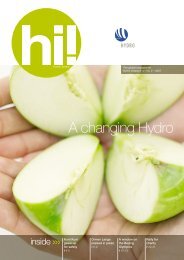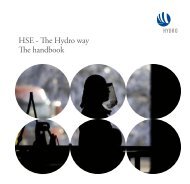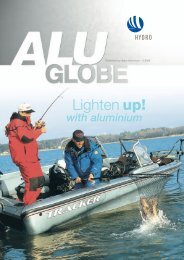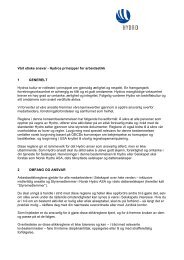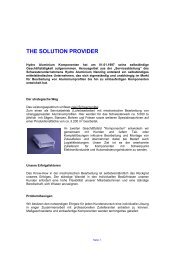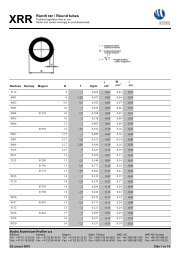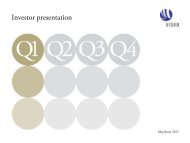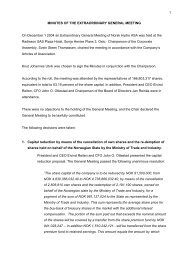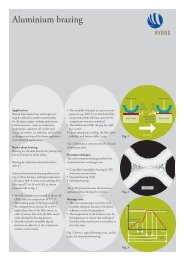Hydro Annual Report 2011b
Hydro Annual Report 2011b
Hydro Annual Report 2011b
You also want an ePaper? Increase the reach of your titles
YUMPU automatically turns print PDFs into web optimized ePapers that Google loves.
FINANCIAL STATEMENTS<br />
Note 35 - Capital management F51<br />
Liquidity management and funding<br />
<strong>Hydro</strong> manages its funding requirements centrally to cover group operating requirements and long-term capital needs. During<br />
2011 net cash provided by operations was sufficient to cover operating requirements and capital expenditures excluding<br />
acquisitions. Funds raised in the Norwegian commercial paper market and from short-term bank facilities were used to cover<br />
short term requirements throughout the year.<br />
<strong>Hydro</strong> has an ambition to access national and international capital markets as primary sources for external long-term funding.<br />
In 2010, <strong>Hydro</strong> raised NOK 10 billion in a rights issue in connection with the Vale Aluminium acquisition, contributing to<br />
liquidity holdings sufficient to cover a related cash payment amounting to USD 1.1 billion in February 2011. <strong>Hydro</strong> also<br />
issued new shares to Vale at closing, representing 22 percent of outstanding shares and assumed US dollar debt as part of the<br />
transaction.<br />
Funding of subsidiaries, associates and jointly controlled entities<br />
Normally the parent company, Norsk <strong>Hydro</strong> ASA, incurs debt and extends loans or equity to wholly-owned subsidiaries to<br />
fund capital requirements. <strong>Hydro</strong>'s policy is to finance part-owned subsidiaries and investments in associates and jointly<br />
controlled entities according to its ownership share, on equal terms with the other owners. All financing is executed on an<br />
arm's-length basis. Project financing is used for certain funding requirements mainly to mitigate risk while also considering<br />
partnership and other relevant factors.<br />
Shareholder return<br />
Shareholder return consists of dividends and share price development. <strong>Hydro</strong> aims to provide its shareholders with a<br />
competitive return compared with alternative investments in similar companies. Our policy is to distribute an average of 30<br />
percent of net income in the form of ordinary dividends over the business cycle. Dividends for a particular year are based on<br />
expected future earnings and cash flow, future investment opportunities, the outlook for world markets and <strong>Hydro</strong>'s current<br />
financial position. Share buybacks or extraordinary dividends may be used to supplement ordinary dividends during periods of<br />
strong financial results after considering the status of the business cycle and capital requirements for future growth.<br />
<strong>Hydro</strong>'s capital management measures<br />
<strong>Hydro</strong>'s management uses the Adjusted net interest-bearing debt to Adjusted equity ratio to assess the group's financial<br />
standing and outlook. Net interest-bearing debt is defined as <strong>Hydro</strong>'s short- and long-term interest-bearing debt adjusted for<br />
<strong>Hydro</strong>'s liquidity positions. Adjusted net interest-bearing debt is adjusted for liquidity positions regarded unavailable for<br />
servicing debt; other obligations which are considered debt-like in nature; and adjustments for the indebtedness of <strong>Hydro</strong>'s<br />
equity accounted investments. The adjustments are considered relevant because they affect <strong>Hydro</strong>'s ability to service existing<br />
debt and to incur additional debt. See table below for additional information related to the definition and measurement of this<br />
ratio.<br />
The ability to generate cash compared to financial liabilities is an important measure of risk exposure and financial stability.<br />
<strong>Hydro</strong>'s management uses Adjusted funds from operations and a ratio of Adjusted funds from operations to Adjusted net<br />
interest-bearing debt as capital management measures. Adjusted funds from operations is defined as Net income adjusted for<br />
non-cash items such as depreciation, amortization and impairments, and deferred taxes. Adjustments are also made for <strong>Hydro</strong>'s<br />
share of depreciation, amortization and impairments in its equity accounted investments as well as for unrealized effects on<br />
derivative contracts and certain other non-cash items.<br />
Adjusted net interest-bearing debt, Adjusted equity and Adjusted net interest-bearing debt to Adjusted equity ratio are<br />
presented in the following table.



